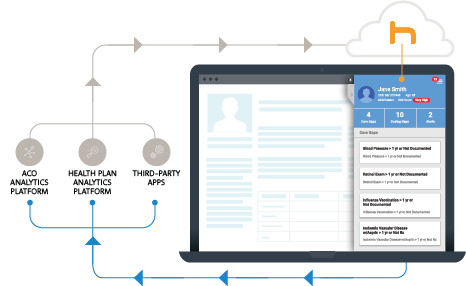
One of the biggest challenges health tech companies face is how to give physicians timely, critical information about patients that fits neatly into their workflows, complements other tech they are using and doesn’t overwhelm them.
Holon Solutions developed CollaborNet®, a precision information delivery system, to provide curated, contextual insights at the point of care. It’s designed to deliver the most relevant patient insights, like gaps in care and information related to population health, administrative automation, and community health such as social services, food banks and transportation, as well as trigger referrals and prior authorizations. It can also be configured to providers’ needs.
Here’s how it works. At a specific workflow trigger event, such as when a physician opens a patient record, Holon’s patented sensors automatically identify the provider and patient in context, and then search for insights relevant to that patient. Curated, relevant information – such as gaps in care, coding gaps, and alerts – is delivered to the provider in a ribbon that displays alongside the patient chart in their electronic health record (EHR) system. The system also identifies members of managed care populations, so clinicians can be more informed about the performance matrix associated with patient care.
Holon’s patented sensor technology extends to referrals, automating initiation from the provider’s EHR by drawing information from the patient chart into the referral form and enabling bi-directional information sharing among providers ensuring an efficient, closed-loop process.
For prior authorizations, Holon sensors make inquiries about the need for authorization during the ordering process. Upon confirmation, the system retrieves the correct clinical evidence, receives the authorization, and places the information back into the provider’s system of record.
Among Holon’s customers are Cerner, NextGen Healthcare, Greater Buffalo Health, Michigan Health Information Network and Clinical Pathologies Laboratories.

Jon Zimmerman
Holon Solutions CEO Jon Zimmerman has a 40-year career in IT and health IT — enough time to have played a role in important milestones but also to learn the lessons from the unintended consequences that can accompany well-meaning attempts to improve patient information access.
Holon Solutions traces its data sharing lineage back to Novo Innovations, a company founded by members of Holon’s executive team. Novo was known for its Grid which combined an HL7-based messaging network with interfaces to clinical apps, known as Nodes and intelligent Agents (lightweight rules-based app) to promote peer-to-peer sharing of clinical records, according to a description from Chilmark Research. In 2009, the company merged with Medicity, which aggregated patient data and made it available at the point of care. Aetna acquired Medicity one year later.
In an interview, Zimmerman shared some insights on his career and how his experience aided the development of Holon’s approach to precision information delivery.
At IBM, Zimmerman had his first experience in developing health IT infrastructure when a healthcare industry customer wanted to reduce manual interference between payers and providers in delivering healthcare and paying for it. He worked with Shared Medical Systems, which wanted to apply the concept of the ATM banking network to healthcare. Zimmerman helped them develop online eligibility data exchange capabilities, which became the main infrastructure of the country. The business later became part of Siemens Healthcare before becoming part of Cerner. It was the beginning of Zimmerman’s journey to figure out different ways to exchange information to make healthcare smarter, faster, and better.
Fast forward to Holon and Zimmerman is continuing his quest to advance healthcare information access by focusing on automating the delivery of it to providers. Zimmerman noted that with all the data created in community EHR and analytics platforms, it can be complicated to access those analytics for specific individuals without disrupting physician workflow and asking them to go to a portal or look at a report.
“Our team was recently awarded a patent in which a provider can open a patient’s chart, catenate the context, and ask whether or not there’s additional outside information known about the individual that will be applicable to give them better care or more accurate coding at that moment. It’s delivered in a consistent user experience. So that’s how we cross the chasm of knowledge that should be known. The analytics can be applied at the moment where it’s going to make a difference, whether the patient encounter is in person or virtual.”

CollaborNet diagram
This precision information delivery approach Holon enlists is based on the concept of precision medicine, according to Zimmerman. “We are getting precisely the information needed by making that contextual catenation.”
One example of precision information delivery in action is the Flint, Michigan water crisis. Holon enabled providers and community resources in that geography to share information about the patients as well as share the information with the community resources. It’s an example that can be applied in multiple situations to improve care coordination and collaboration.
A physician taking care of a patient could refer them to a particular resource be it clinical or community support, depending on what that receiver wants to know about this patient. Users can trigger an invitation to a conversation, in the form of a referral. Alternatively, they have an open channel to come back to the physician and request the patient’s lab results, radiology report, and more, without requiring a big infrastructure lift for either party.
“We have an active program with Cerner to be able to roll this out across [Cerner’s multi-purpose, programmable, cloud-based population health platform] Healtheintent because they and their customers realize how terribly important it is to be able to coordinate the last mile of care, and to get those insights back into the system for continuous improvement.”
Holon takes a nuanced approach to its healthcare organization customers. Its context generation system covers multiple disciplines because patients’ needs may vary a great deal from pediatric care to people with chronic conditions.
“A care plan for a child is going to be different from a congestive heart failure patient, which will be different from an oncology patient, but the processes in the delivery of the information can and should be consistent,” says Zimmerman. “That’s what enables us to establish relevance in the moment while helping health systems be adaptive to change.”
Holon recently signed a partnership with Referral Point, part of a plan to get more distribution partners and add more value because these connections are some of the missing ingredients to optimize the effectiveness and value of care delivery and community support.
Looking ahead, Zimmerman noted that there are a couple of important trends that will remain consistent with what Holon is trying to do, whether the encounter is in an office or through telemedicine.
“The complete delivery of the care plans and the complete delivery of the coding and representation of the care plans is still an open need. So, regardless of setting, the processes will be the same. It is incumbent upon us to be able to fit those environments and we are making sure that that happens.”
Another component soon to be part of Holon’s offering will be supporting telehealth and remote patient monitoring systems. Keeping health systems and practices aware of what’s going on with patients wherever they are is an emerging trend that will continue, Zimmerman observed. It’s not just a televisit, so much as “tele-management” of patients for their best possible quality of life.
“We believe that delivering the right information at the right place at the right event is going to continue to be a trend in respect to the changing care delivery and care management modalities,” Zimmerman says.
He adds: “There are good, aligned incentives that come from value-based care. We know that it is important to not only treat the person for whatever condition they may have, but it’s also important to be aware of their social environment, social determinants of health. We know that the datasets available for all those things are not consolidated, nor do we see them becoming consolidated any time soon. If you need to deliver community-based care now, that’s only going to get more complex because there are more programs and more players. It’s important to have an intelligent information assistant because all those dynamics are going to go up, not down.”
The evolution of patient data management has had to contend with setbacks that have led to physician burnout. Zimmerman’s vision for the company seeks to deliver precise, contextualized information for clinicians that reduces the burden on clinicians and makes the flow of data more responsive to the demands of patient care and population health.
In closing, Zimmerman added, “We all deserve a better operating healthcare system with better served providers. Thoughtful information technology can and must help. There is no time to waste.”
Photo: AndreyPopov, Getty Images






